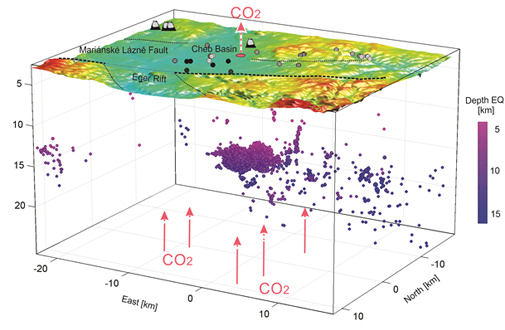Laboratory in situ to study fluid driven earthquakes and deep biosphere

Perspective 3D view of the earthquake swarm region in West Bohemia/Vogtland. Hypocentres are indicated by filled colour circles.
Topography is indicated as coloured map and ranges between 400 and 800 m. CO2 mofettes at the surface indicated,
black to grey circles indicate 3He/4He ratios between 6 Ra and 0, respectively. Tectonics and known Quaternary volcanoes are indicated.
Open questions
- Where, at which depth and stresses are the magmatic reservoirs and heat anomalies?
- What controls the pathways of magmatic fluids through the crust and how do they look?
- Are there spatial and temporal correlations between deep magmatic processes, earthquake swarms and changes in fluid degassing and microbial diversity?
- What are the physical and chemical processes leading to earthquake activity and fluid mobility?
- Which and how do the geological processes influence the deep biosphere and can microbes be used to reveal the history of paleo CO2 flux in maars?
- Develop modern, comprehensive laboratory in situ with high detection capability
- Study earthquake swarms, CO2 degassing and deep biosphere and their interactions
- Understand fluid and magma migration, and fluid-rock interactions through the crust
- Map structural heterogeneities in the swarm region
Web administrator R. Beranek (2020)